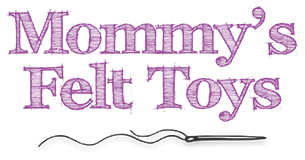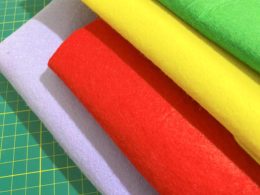Table of Contents
Over the centuries, a wide variety of embroidery techniques and stitches have developed around the world. You can get an overview of all the stitches I’ve used so far in my post.
If you’re still new to embroidery, I highly recommend starting with the basic stitches first. Sometimes diving into this sea of intricate stitches can be overwhelming and discouraging. However, learning different types of embroidery stitches is not as difficult as you might think. With practice, you can quickly master felt embroidery!
See Also: Felt Crafts for Beginners – The Complete Guide
At first, glance, learning new hand embroidery stitches can appear daunting. There are nearly 300 hand embroidery stitches, yet many current embroidery patterns use a few fundamental stitches. If you can master these, you can sew the most modern embroidery designs! If you manage to learn one stitch at a time, you’ll soon be able to sew anything you want!
Over the centuries, many embroidery stitches have been developed all over the world. There are easily over 300 hand embroidery stitches in all variations. Each can be changed in width, length, and material to create a different look. This makes hand embroidery versatile and creative.
See Also: Which Thread Is Best for Sewing Felt
You can learn many embroidery stitches, but you only need to know a handful of embroidery stitches. Usually, 9 different embroidery stitches are used in felt designs. These 9 types of stitches make the perfect foundation for your felt craft projects. Most of these stitches are basic stitches such as running stitch, backstitch, or blanket stitch. The type that may take some practice to master is the French knot.
What are the basic hand embroidery stitches?
Stitches that constitute the head of a family of stitches are known as basic embroidery stitches. These stitches establish the stitch type or category for the entire family. A stitch family is a collection of stitches with a common trait, even though they appear to be somewhat dissimilar.
In this article, you’ll find all the basic hand embroidery stitches along with their tutorials below. I started with the most essential embroidery stitches for beginners, so it’s easier for you to decide which ones you need to learn first.
If you are a beginner and need more information on starting and finishing threads, choose materials. This beginner embroidery post can help you. Inside, you’ll find all the starting questions answered and more.
What are the Embroidery Stitch Types and Their Purposes?
With hand embroidery, you can decorate clothes and other textiles, create home decorations and accessories, repair textiles, or strengthen them to not puncture. Stitches can be divided into four categories, each providing different effects and uses for embroidery designs:
- Embroidery stitches for outlines: These stitches outline the elements of your design. Running stitch, back stitch, and split stitch are excellent examples of outline embroidery stitches.
- Embroidery stitches for edging and attaching appliqué: These stitch types are used for sewing and adding appliqué. They are commonly used in felt crafts to sewing two pieces of felt together. Blanket stitch, whip stitch, and running stitch for felting are stitches used to finish a seam.
- Decorative embroidery stitches: These are used to create decorative details, add texture, and fill space in a design. The French knot and fly stitch belong to the category of decorative stitches.
- Embroidery stitches for filling: Filling stitches are used to fill in a specific part of the embroidery design or create shading. The satin stitch is a classic type of embroidery stitch used to fill in a space. Cross stitch is another example of this type of stitch.
You can use embroidery stitches in felt craft projects for the following purposes:
- Sewing two pieces of felt together
- Sticking the appliqué to the felt
- Creating and filling in outlines, e.g., for sewing eyes, mouths on finger puppets.
- Decoration
As with all sewing techniques, practice gets better. Pay attention to your stitch size, length, and consistency. If you are not satisfied with the finish of your stitches, you can remove the stitch and start over.
Running stitch
The running stitch is probably the simplest and most basic embroidery stitch. Still, you can get the most exciting patterns or minimalist line stitches with the running stitch. The running stitch works in a simple up and down motion. The running stitch, for example, is the primary embroidery stitch used in Japanese Sashiko needlework and various patchwork styles.
The running stitch is a standard embroidery stitch used to outline a design or make straight or curved lines. Don’t get fooled when you hear the terms “running stitch” and “straight stitch.” They are two different sorts of stitches. The running stitch is simple to learn, and you can create various effects by altering the length of the straight stitch and thread thickness.
Do not pull the thread too far in the running stitch, or the fabric may fly off.
Chain stitch
You can easily replace the backstitch with a chain stitch in most line stitch patterns. The chain stitch is worked into loops, then fixed by the next loop or a stitch. You can use the chain stitch to embroider all areas you specify, or you can just use it to create a line.
Root stitch
Root stitch is like a string. Slanted sections allow this stitch to blend single stitches into a neater line than the more prominent backstitch or chain stitch sections. The root stitch is embroidered from left to right. Individual stitches are longer and offset than the previous one.
French knots
The French knot is a decorative stitch. Used to create texture or fill space in a design. French knots are part of the knotted stitch family and are often used to highlight embroidery pieces.
If clouded together, they create a very textured surface, but they also look greatly scattered around. To make a French knot, wrap the yarn around the needle many times before starting. Then you can carefully sew it to the felt from the side where the thread comes out of the fabric.
Satin stitch
The satin stitch is a classic embroidery stitch used to fill in a space. You can create all kinds of smooth shapes using this method. It is known for its closely spaced straight stitches. It may not appear ideal at first, but with practice, the length and closeness of the stitches will improve dramatically.
There are two options for satin stitching. First, you mark the shape you want to sew satin and embroider by following the markings. In the second option, you sew an outline with a backstitch and embroider on it. The second option is easier to embroider for beginners.
Satin stitch is commonly used as a fill stitch. Its name comes from its smooth surface, which resembles the surface of a fabric called satin. Set multiple stitches parallel to each other along your shape to embroider and fill the satin stitch.
Herringbone stitch
Herringbone stitch is cross-stitch. It is widely used to fill areas with a low amount of waste yarn on the back. To embroider the herringbone stitch, make 2 sets of worked stitches intersect above and below the line.
Blanket stitch
The blanket stitch is another basic embroidery stitch for felt. Used along the edge of the fabric to finish the fabric, add appliqués or embellish lines. Getting started with blanket sewing is usually the most challenging part. Still, it’s straightforward once the first step is done.
The blanket stitch is often used to hem blanket edges. Blanket hand embroidery stitch is worked from left to right. Imagine two parallel lines and stitch loops running up from the bottom row.
Cross stitch
Cross-stitch is probably the only stitch almost everyone sews at school once in their life. It’s also a term many people say when they actually mean hand embroidery. Cross stitches are 2 sets of stitches worked on top of each other.
Fly stitch
The fly stitch can be used as a particular stitch for stamps and other items having a semicircle or oval shape. The linked version is excellent for small leafy branches or flower stems. I like to use the fly stitch for pine branches often in Christmas embroidery. The fly stitch is embroidered from top to bottom. Make wide open loops first and secure each one separately with a longer stitch.
Straight stitch
A straight stitch is similar to a pencil line, and it can be used for anything. Depending on how you arrange the stitches, how long or how short you make them, straight stitches can be anything you want them to be. There are many interesting shapes you can explore in the straight stitch family.












